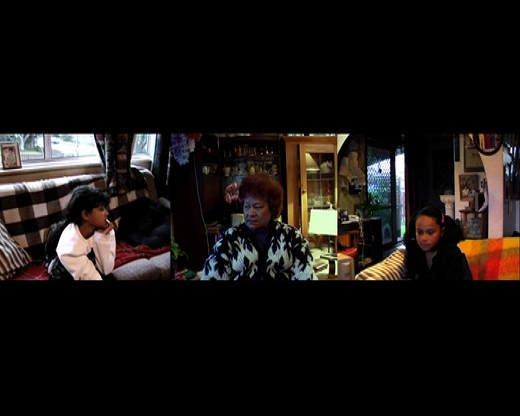As a New Zealand-born Samoan child, I always tried to play the "islander card." I wanted to prove to my grandmother that I was Samoan. I would eat the masi saina to prove that I liked island food, even though the thought of eating baked pork fat was not appealing to my 8-year old self.
Walking into the Gus Fisher Gallery for the recent survey Black Bird: Lonnie Hutchinson 1997 – 2014 you are greeted by the 3 channel video Fish Eyes (2007). Sitting in a living room, Susana Luafutu Hutchinson (the artist’s mother), Sinalei and Losana Tuiletufuga (the artist’s nieces, aged nine and ten) chat about food and career goals. Susana, Sinalei and Losana talk about the foods they like; carrots, eggplant, coconuts, fish. One likes fish eyes; the other is appalled by the thought. Each screen focuses on a different person in the 3-way conversation, food and appearance embodying both collective and personal identity.
In the context of the South Pacific, food is ingrained with complex narratives of slavery and colonialism. There was a time when no one used coconut oil as a moisturiser and the smell of it in your hair was an automatic sign of being an outsider. The coconut, a food which has risen to extreme popularity for its numerous health benefits, is also a symbol of racist slander.
A common subject in Hutchinson’s work is "Black Birding." While commonly defined as Kanakas working on sugarcane and cotton plantations in Australia, Black Birding also references a much wider connection to Pacific slavery on Plantations in the late 19th Century. In the mid-1800’s, ships combed the eastern Pacific islands to fill labour shortages in Peru. During the German rule of Samoa pre-1914, full-scale plantation operations started. Monopolising their coconut, cacao, copra and cocoa bean resources, German traders brought in Chinese, New Guinea and Melanesian labour forces.
Hutchinson’s practice is commonly discussed within grand narratives of Pacific history and feminist perspectives. In a catalogue essay accompanying a previous show, feminist theorist Abigail Solomon-Godeau uses Hutchison’s large-scale carbon paper triptych Milk and Honey (2012) as a point from which to explore the repression of lesbian sexuality in Pacific Island cultures.
While Solomon-Godeau’s piece makes sense in contextualising the work within wider feminist narratives, the writing around Milk and Honey avoids any interpretation based on the artist’s own sexuality. When considering these grand narratives, the maker is intrinsically woven into the narratives and connotations of works they produce. Daniel Michael Satele recently commented that a piece of writing is a self-portrait. The same can be said for art making.
In Fish Eyes, however, the connection to the personal is undeniable. Susana, Sinalei and Losana are at home. By feeling comfortable they lose inhibitions, creating an entrance point for the work. As human beings there are shared experiences that we all feel connected to, whether that is being in love or simply sharing food with family. Although we are all individuals, something which seems so personal is also incredibly universal. Through the innocence of the child, the personal becomes the grand history.
